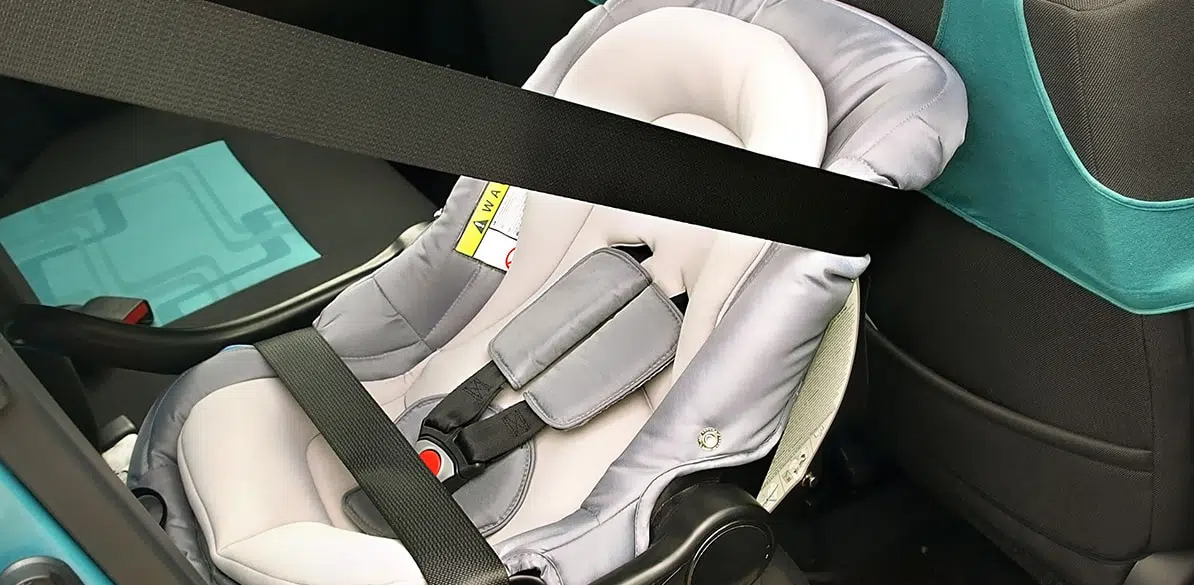When is it safe to use a forward-facing car seat?

Why is it important for your baby to face backwards in the car?
Road safety for infants and toddlers is a priority for every car journey. One of the most important issues is the way the car seat faces. We know that small children must travel facing the rear of the car.
This is stated, for example, in regulation R-129 (i-Size), which requires all R-129-approved child restraint systems to be rear-facing for children up to 15 months of age. But how long should they stay in this position?
Is 4 years old the age limit or should they travel rear-facing for as long as possible? Child restraint systems (CRS) approved under this regulation require young children to travel rear-facing until they are at least 15 months old. This position reduces the impact on the child’s head and neck in the event of a collision, considerably increasing their safety.
For how many months should infants travel backwards?
In Sweden, it is typical for children to travel in a rear-facing position. “If you ask a parent in Sweden to describe what car seats are like, 95% will tell you that they are rear-facing”, explained Tommy Peterson, director of the VTI Crash Lab and Plus Test Manager on the ‘1st Rear-Facing Day’, which was recently held in Spain. Countries like Sweden, leaders in child safety, recommend that children travel backwards for as long as possible, even until they are 4 years old or more, which means at least 48 months.
This is because, in a collision, rear-facing CRSs can reduce the risk of injury by up to 95%, as the seat absorbs the energy of the impact, protecting the baby’s delicate bone structure.
In this same Nordic country, CRSs are approved under European regulations (R44/04 and R-129) but for them this is not enough, as the regulations do not cover the ‘forces’ exerted on the neck. That is why it uses the Plus Test label, which is optional for car seat manufacturers but means that the CRS in question is particularly safe. In this test, rear-facing car seats are the clear winners (click here to check what the Plus Test consists of and which car seats have this rating).
According to safety studies, an infant’s head represents up to 25% of their total body weight, compared to 6-8% in adults. This imbalance means that, in an accident, the weight of the head, together with the poorly developed neck muscles, can significantly increase the risk of serious injury. In addition, when traveling rear-facing, the back of the car seat supports the weight of the baby, decreasing pressure on the neck and reducing the risk of neck injuries.
When should your baby’s car seat be forward-facing?
The transition to a forward-facing seat should be made carefully and only when the infant has achieved the physical development necessary to travel safely in this position. Although regulations require that babies travel backwards until they are 15 months old, safety recommendations suggest that it is better to extend this period until the child is at least 4 years old or as long as the child’s size and weight allow.
Some manufacturers, like Volvo, suggest keeping your childin a rear-facing position until they are 3 years old, or even older if possible. Although many parents think that the forward-facing position may be more comfortable for the child, in reality rear-facing CRSs allow the child to ride safely and comfortably, even if the child’s legs are somewhat bent. The baby’s safety is not compromised by this leg position, and the seat still provides optimal protection.
Safety factors and child anatomy: our recommendations
Fundación MAPFRE recommends that children travel in a rear-facing position until they are at least 4 years of age (48 months) and, whenever possible according to the child’s physical condition, for as long as possible. Remember that a baby’s head is proportionally much larger and heavier than the rest of its body. While an adult’s head accounts for about 6-8% of their total body weight, child anatomy is different, and their head can account for as much as 25% of their total body weight. On top of this, the bones and muscles in their neck have not yet developed enough to support their relatively heavy head. In addition, a baby’s head circumference (infant growth patterns) also develops along with other patterns such as weight and height as the child grows.
Moreover, the neck is usually the area that suffers the most in an impact. This is why adults often suffer whiplash. For children, the consequences can be much worse because of the greater weight of the head and the fact that the bones in the spinal column are not fully developed. To this we have to add the strong restraint provided by the harness, which means only the head can move if there is a traffic collision.
We remind you that children must travel in child restraint systems whenever they are less than 135 cm tall, as stated in Spanish regulations. However, Fundación MAPFRE recommends that CRSs continue to be used until the child is 150 cm tall, as stipulated in European Directive 2003/20/EC.
Benefits and disadvantages of forward-facing and rear-facing baby seats
Traveling backwards has numerous advantages in terms of safety. Studies show that rear-facing CRSs protect not only the child’s head and neck, but also their arms and legs by preventing them from moving forward abruptly in the event of a collision. This reduces the likelihood of fractures and serious injuries, making the rear-facing position the safest option.
Fundación MAPFRE has conducted studies of child car seats, and the results show that rear-facing CRSs reduce cervical and cranial injuries, offer greater impact absorption in frontal collisions, and protect the developing spine of young children.
Benefits of traveling backwards:
- Fewer neck and head injuries.
- Increased shock absorption in frontal collisions.
- Protection for the spine, which is still developing in young children.
Disadvantages of traveling forward-facing at a young age:
- Less protection for the neck and head.
- Greater risk of injury in the event of an impact due to the forward-facing position.
When deciding to change your baby’s car seat to a forward-facing position, it is essential to consider their weight and size, according to the manufacturer’s recommendations. Experts stress that the child’s safety in the car can be compromised if the change is made too early, so it is essential to respect the recommended times.
Tips for using baby car seats safely
To ensure safe use of the car seat, whether rear-facing or forward-facing, it is important to keep a few recommendations in mind:
- Check the approval: Make sure that the child restraint system is approved according to current European regulations, such as R-129 (i-Size), which requires seats to be rear-facing until the child is at least 15 months old.
- Follow the manufacturer’s instructions: Each seat has different specifications. Respect the recommended weight and height limits, and check that the seat is correctly fitted into the vehicle.
- Do not use unauthorized accessories: Some items such as additional belt protectors or head restraints can compromise the effectiveness of the CRS. It is important that you only use accessories approved by the manufacturer.
- Ask your pediatrician: If you have questions about the right time to switch to a forward-facing child car seat, ask your pediatrician for a personalized recommendation based on your child’s physical development.
- Can my car be immobilized if my child is not using a child car seat? In some cases, the authorities can apply significant penalties or even immobilize your vehicle if you do not comply with child safety regulations.
This video clearly explains the big difference in a rear-end collision.
Your baby’s transition to a forward-facing CRS is an important decision in terms of road safety. By following these tips and complying with current regulations, it is possible to ensure a safe and comfortable ride for your baby, both rear-facing and forward-facing. If you want to find the best seat for your baby, we recommend that you review our complete guide to child seats.
Your baby’s transition to a forward-facing CRS is an important decision in terms of road safety. By following these tips and complying with current regulations, it is possible to ensure a safe and comfortable ride for your baby, both rear-facing and forward-facing.
If you would like to know how to choose a seat and which one is best-suited to your baby, we recommend that you check out our complete guide to child seats.
Finally, this other video also shows the difference between traveling looking backwards and not.
